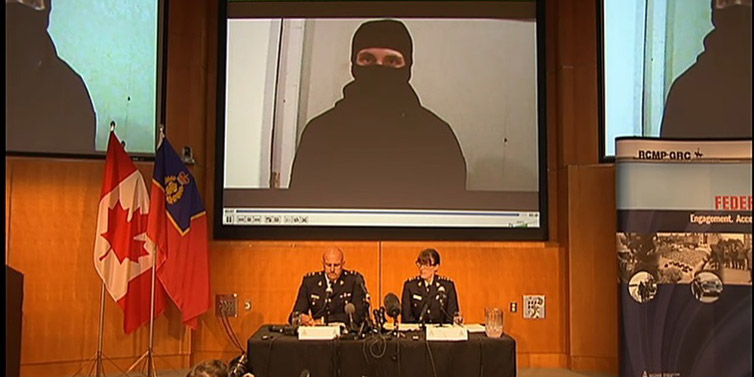Quick response from RCMP prevents potential terrorist attack
 CREDIT: SCREENSHOT FROM THE CBC NEWS LIVESTREAM OF THE PRESS CONFERENCE ON AUG. 11, AT THE RCMP NATIONAL HEADQUARTERS IN OTTAWA.
CREDIT: SCREENSHOT FROM THE CBC NEWS LIVESTREAM OF THE PRESS CONFERENCE ON AUG. 11, AT THE RCMP NATIONAL HEADQUARTERS IN OTTAWA.Deputy Commander Mike Cabana (left) and Assistant Commander Jennifer Strachan, Commanding Officer of O Division (Ontario) (right), present a martyred video of Aaron Driver, who planned to bomb a Canadian City.
The southern Ontario town of Strathroy, west of London, became the setting of an international storyline with the capturing of a 24-year-old man who was suspected of being a “potential terrorist threat” according to an RCMP statement.
In the statement released Aug. 10, the RCMP “received credible information” of the threat.
“A suspect was identified and the proper course of action has been taken to ensure that there is no danger to the public's safety,” the release said. “The safety and security of Canadians is of the utmost importance to the RCMP and we take all such threats seriously.”
During a press conference held on Aug. 11 at the RCMP National Headquarters in Ottawa, Deputy Commander of Federal Policing Mike Cabana and Assistant Commander Jennifer Strachan, Commanding Officer of O Division (Ontario), all noted how quickly the chain of events happened.
Aaron Driver, who police identified as the suspect engaged in a confrontation with police and later died, an RCMP update stated.
Strachan said there will be an autopsy to determine the exact cause of death, whether it was from the firearm deployed or an engagement with police.
“[The event] ended rather tragically,” Cabana said, “But could have had a completely different ending with a significantly greater loss of life.”
According to Cabana, the RCMP received credible information around early morning on Aug. 10 from the FBI, along with a martyrdom video prepared by an “unknown person clearly in the final stages of planning an attack with a homemade explosive device.”
He said the attack was supposed to take place in the following 72 hours, targeting an urban centre, either during the morning or afternoon rush hour.
Though the exact location is still unknown, Strachan said Driver was looking for a location hugely populated.
Once the RCMP was made aware of the situation, Cabana said they took immediate action to “ensure the public’s safety.”
“We actively engaged relevant Canadian law enforcement and security agencies, asking them to exercise an increased level of vigilance and to be on the lookout for anything suspicious.”
Throughout the investigation, which is still ongoing, analysts were able to identify the suspect through the means of snapshots and the video, as Driver, who was known to RCMP for previous Islamic involvement.
According to the RCMP update, Driver was under a [810.011] peace bond related to terrorism.
Police were able to locate Driver, who was originally living in Winnipeg, but moved to live with his sister in Strathroy, while on the peace bond that was supposed to have him away from the computer, social media and his phone.
The ankle bracelet he was wearing was also removed in February 2016.
The martyrdom video shows Driver, a radicalized ISIS follower, dismissing Canada and declaring his hate, as well as saying fire burns in the “heart of Muslims”.
Cabana said the videos shows the individual uttering imminent threats towards Canada and clearly suggesting he would be taking action.
“How quickly this was all established is accurately a testament to the level of collaboration with law enforcements agencies in Canada and the US,” Cabana said.
According to Strachan, Driver was spotted by police late afternoon on Wednesday on Park Street getting into a cab, when a device detonated in the back of the vehicle, leaving the cab driver with minor injuries. It is not clear if the device was attached to Driver, or if it was attached to a bag he had with him.
Strachan said the team is not sure if Driver had an accomplice.
Although Driver was under court order with restrictions that included surveillance, it was a peace bond, meaning it was not possible for 24/7 constant surveillance, Cabana said.
Strachan said that with the peace bond, police knew where he was living and was in contact with his family, who were trying to “bring him through the situation he was in [radicalization]”.
Both Cabana and Strachan said it’s pre-mature to see how and what materials he acquired to make the explosive.
Cabana did say that the Internet is a relatively easy place to obtain the knowledge and material to make such a device.
Cabana said the RCMP knew Driver was a threat, but any indication of this case was unknown.
Though not qualified to speak about Driver’s mental state of being, he did say the Internet likely played a “significant role” in radicalizing him with ISIS propaganda.
“Clearly with this case, when [an] individual has these kinds of intentions like Driver had, there are no conditions that can be put in place to prevent them from taking [said] actions,” Cabana said.
Strachan said that with this case, along with any others the RCMP and their team works with, they evaluate and see how they can do better next time.
The two officers were pleased at how well everyone responded and worked quickly.
It was a “race against time” Cabana said.
The national terrorism threat level in Canada remains at medium, which is where it’s been since fall 2014.














